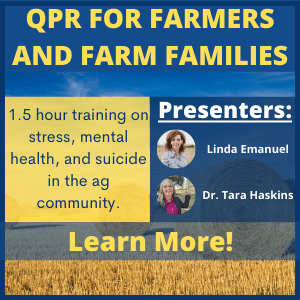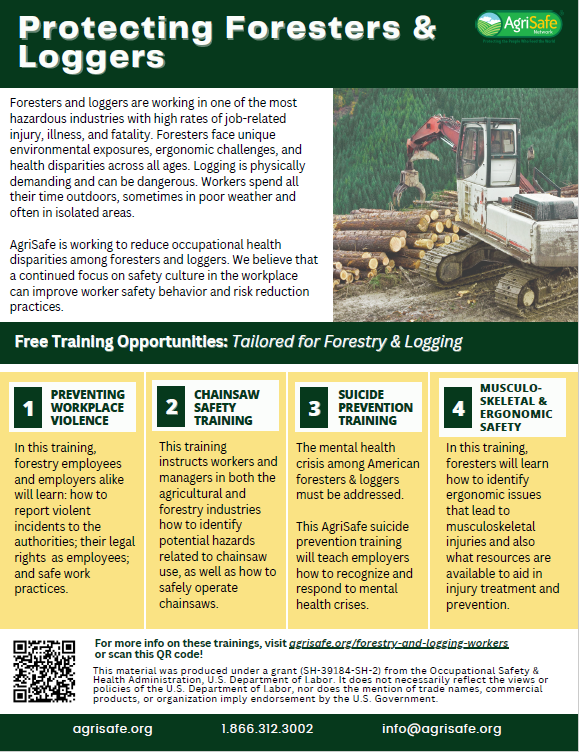Last updated on June 21st, 2024 at 03:27 pm
Foresters and logging workers face many physical dangers. They are a part of one of the most hazardous industries, with high job-related injury, illness, and fatality rates. Foresters and loggers have a physically demanding and dangerous job. Additionally, these workers are exposed to a combination of factors that stem from the work environment or processed materials. They are exposed to extreme temperatures, poisonous plants, pesticides, attacks from wild animals or stinging pests, and constant pressure to work harder and faster which exposes these workers to specific challenges that workers in other sectors will not typically encounter.
AgriSafe is excited to announce that we are working to reduce occupational health disparities among foresters and loggers. We believe that a continued focus on safety culture in the workplace can improve worker safety behavior and risk reduction practices.
Training topics include:
- Chainsaw Safety Training
- Combating Heat and Cold Stress for Forestry Workers
- Hearing Loss Prevention for Forest Workers
- Musculoskeletal and Ergonomic Safety for Forest Workers
- Preventing Workplace Violence for Forestry Workers
- Skid Loader Safety
AgriSafe staff can provide training on these and other topics to your employees or group.
Click here to Request a Training.
Webinars
| Webinar Title | Summary | Link |
|---|---|---|
| A Review of the Literature for Forestry Health and Safety: The Last Ten Years | Last updated on June 21st, 2024 at 02:34 pmForesters and loggers work in the most hazardous industries with high job-related injury, illness, and fatality rates. This workforce faces unique environmental exposures, ergonomic challenges, and health disparities across all ages. The last comprehensive literature review in forestry health and safety for NIOSH was completed in 2012. Under a NIOSH IPA project, AgriSafe conducted a forestry health and safety literature review for publications from 2012 to 2022. The objectives of this review were: Uncover the health and safety issues currently facing the forestry and logging workforce. Identify any new trends or topics in the literature. Identify areas of training and health needs. Identify healthcare access issues impacting the forestry workforce. Final results of this project will be shared with the audience. Findings in this project will contribute to NIOSH’s priorities for forestry occupational health and safety and the literature. The literature review will inform and prioritize future forestry training needs through AgriSafe’s OSHA forestry training … | |
| Chainsaw Safety Training | The Chainsaw Safety training program is intended for workers and managers in the agricultural and forestry industries. The major focus of the program is on the identification of and the safe operation of chainsaws. According to the Centers for Disease Control and Prevention (CDC), approximately 36,000 people are injured by chainsaws annually. | |
| Combating Heat and Cold Stress for Forestry Workers | Forestry workers may be subject to extreme heat and cold. Working outdoors makes people more likely to become dehydrated and experience heat-related illness or heat stress. High temperatures reduce work capacity and may lead to heat stress and dehydration. Although exposure to heat stress is preventable, thousands become sick from occupational heat exposure every year, and some cases are fatal. Similarly, cold weather can reduce dexterity, blood flow, muscle strength, and balance. Hypothermia, frostbite, trench foot, and chilblains are all illnesses and injuries caused by cold stress. However, forestry workers can avoid heat-related illness and cold stress with proper information and preventative action. This presentation will explore both weather-related conditions and their impact on outdoor workers. | |
| Hearing Loss Prevention for Forest Workers | Hearing loss is common, especially among workers who are exposed to hazardous noise where they work. Forestry and Logging are among the top industry sectors for worker exposure to hazardous noise that can contribute to hearing loss. According to The National Institute for Occupational Safety and Health (NIOSH), noise-exposed workers in Forestry and Logging had a higher percentage of hearing loss (21%) than all noise-exposed industries combined (19%). This training will discuss effective methods for preventing hearing loss from noise in … | |
| Musculoskeletal and Ergonomic Safety for Forest Workers | Forest workers face unique ergonomic challenges due to their exposure to extreme environmental conditions, heavy workload, and dangerous tools and machines. The forest sector has one of the highest rates of Musculoskeletal Disorders (MSDs), almost 100 times higher than the industrial targets the National Institute for Occupational Safety & Health (NIOSH) set. This program is intended to help forest workers identify ergonomic issues leading to musculoskeletal injuries and discover resources to aid in injury treatment and prevention. | |
| Preventing Workplace Violence for Forestry Workers | Forestry and logging workers are exposed to a range of biological hazards, extreme weather, accidents, and – especially for women– assault. Workplace violence is violence or the threat of violence against workers. This training will review the many forms of workplace violence among co-workers, including sexual harassment. The federal Occupational Safety and Health Act (OSH Act) states that “each employer shall furnish to each of his employees’ employment and a place of employment which are free from recognized hazards that are causing or are likely to cause death or serious physical harm to his employees.” In this presentation, AgriSafe will focus on educating forestry employees and their employers on reporting violent incidents to authorities, informing employees of their legal rights, and safe work practices. | |
| Skid Loader Safety | Skid loaders are useful and versatile machines in the hands of appropriate operators. To utilize them to their utmost, we must understand there is inherent risk in the operation of the machine. This class will talk over some of the basics of skid loader operation including why there should be no passengers, proper transport, safety features, and blind spots. | |
| Stress Control Strategies for the Forestry and Timber Workforce | Stress can directly impact safety. Whether managing forestry wildfires or working long strenuous days harvesting and hauling timber, the forestry and logging workforce face unique situations that can predispose stress and challenges to mental well-being. The agriculture, forestry, fishing, and hunting (AgFF) industries has one of highest percentages of deaths by suicide. Key factors contributing to despair and distress include financial losses, chronic illness or pain, a sense of work-life imbalance, and lack of mental health support. This session will explore the topic with a review of specific risk factors, and discuss ways to support this workforce in an unpredictable environment. Read More | |
| The Ergonomics of Hand Planting Reforestation Work | Reforestation work is vital to the health of America’s forests and the U.S. economy. Hand planting, a common reforestation practice, provides unique challenges to safety and health practitioners interested in reducing occupational injuries and illnesses. This webinar will share lessons learned from a team of investigators studying occupational exposures to physical risk factors among hand planters in the Southeastern United States. |


